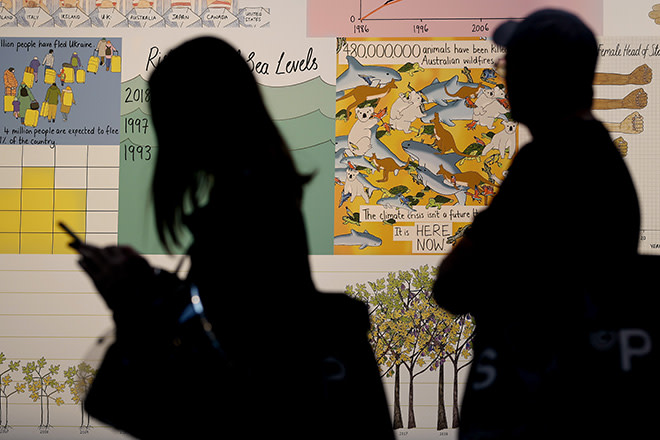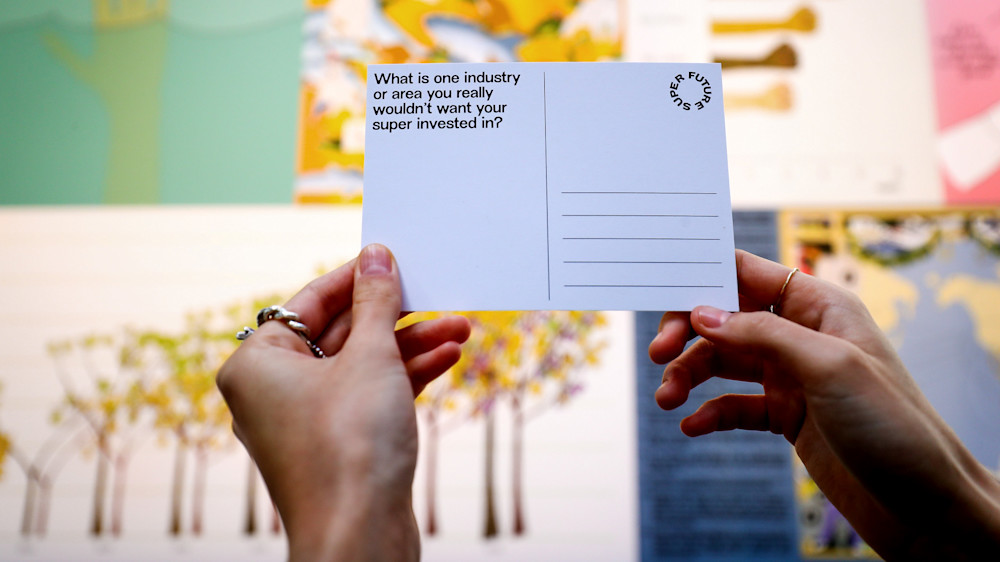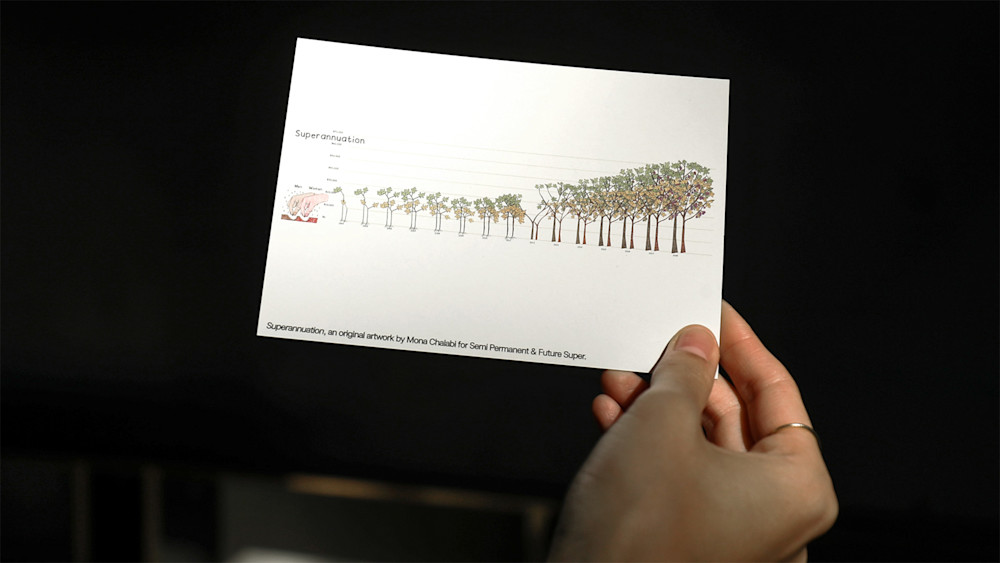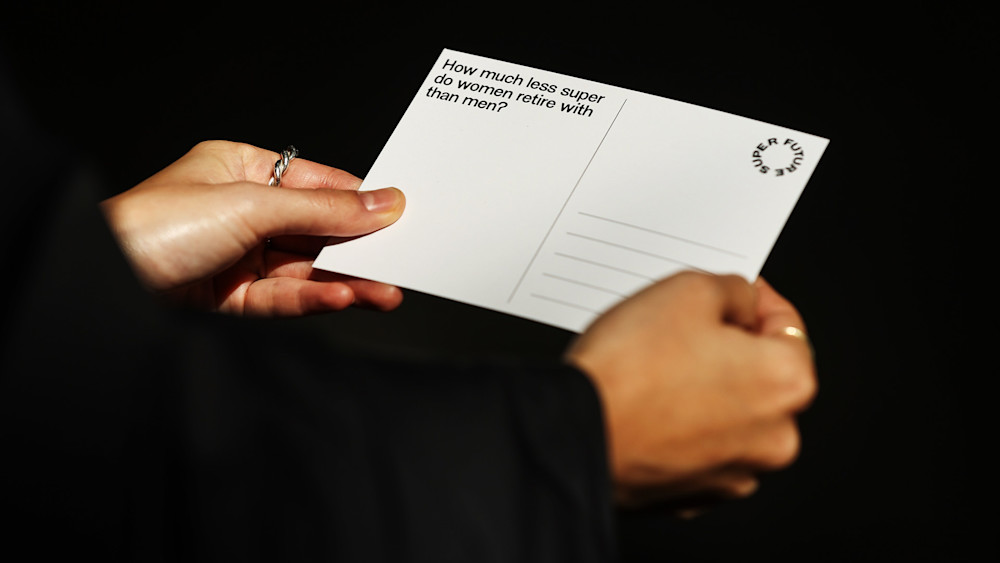Making numbers make sense, with Future Super and Mona Chalabi

Do you usually gloss over the fine print? That important but somewhat obscure information on the back of a medical prescription, or a financial contract, or some other document that comprises the facts and figures about something that’s crucial to the decisions you make about your life? Tables, graphics, charts, and numerals – they can be informative, but on the surface, this type of information is often cold and decipherable, and so typically disconnected from our day-to-day reality. How are we to understand, and make informed decisions, about our future, if we can’t make the numbers make sense to us?
As part of Semi Permanent Sydney, we collaborated with Future Super to show ways in which information might be reframed and conveyed, demonstrating the power of creativity in wading through the density of data that exists in the world. Or, to put it more simply (and more Australian), to help to cut through the bullshit. The superannuation fund exists with a purpose to create a prosperous future free from climate change and inequality. It knows that this industry is worth more than $3.3 trillion, and that just 7.2% of Australia’s super would be enough to fund a transition to 100% renewable energy. Future Super’s business-as-usual approach is all about helping people realise the power their money has in building a future worth retiring into. Because do you know what your super is invested in?
As part of our partnership, we engaged recent Pulitzer Prize-winning writer and illustrator Mona Chalabi (a keynote speaker at our event) to create a new artwork, drawing on the data that shows that women are retiring with between 40 and 47% less super than men. In fact, women in Australia earn $1 million less, on average, over their lifetimes than men, and retire with $136,000 less in superannuation, with women earning the median wage often falling well below the level defined as a “comfortable retirement”.


“I was a little bit fearful about [this project], if I’m honest,” explained Chalabi upon touching down in Sydney ahead of the Semi Permanent festival. “I’d not heard the word superannuation, and I also haven’t started saving for my retirement – not a single penny. And in the process of doing this I spoke with a lot of Australian friends who were like, ‘My god, Mona, you need to start saving!’”.
As is Chalabi’s much-loved aesthetic (she boasts over 400,000 passionate Instagram followers, many of them acquired during the Covid years where she famously helped to convey key information that was, at the time, being obscured by the American government), the resultant illustration is playful in its approach. Displayed in the form of a simple bar chart, Australian figs are seen in different stages of their growth, from nascent seedlings through to full, fruit-bearing trees. It’s a simple analogy – of watering, caring for, giving light to a plant to help it grow into something healthy and big – but in comparing that level of support between the average male and female salaries, and considering the high-growth years sometimes missed by women through maternity leave or otherwise, the inequality becomes clearer yet. We can imagine it in real terms through something, in this case a tree, that we inherently understand.

“Often my first step is to do a Google Image search to see what the existing visual language for a particular subject matter is, and very often it’s quite crap,” explains Chalabi of her creative process. “If I’m doing a piece about depression, for example, you do a search and it’s images of white men in business suits doing this,” she says, as she rests her head in hands solemnly. “But that isn’t what depression looks like, and nor is superannuation just these numbers that exist on a page. So, very often I’m trying to use or develop a new visual language, but one that’s still instantly recognisable. I want you to be challenged, but I also want you to see the images before you see the words, and when you see the images for your brain to already have a bit of a sense of what this is about, or at the least, that it intrigues you enough to be pulled in.”
Chalabi is in praise of the statisticians she often works with, but she’s cognisant of the limitations that exist in raw data. “In this illustration it was quite tricky to show the differences through colour, representative of men and women, and that brings us back to the gaps: there’s often no data on non-binary people, or trans people, and if there was, I’m sure that data would reveal even further injustices. The data very often doesn’t show the most vulnerable groups, and so in some ways my work only ever really shows a portion of what’s happening.”


The thing about Chalabi’s work that is so resonant with audiences is, as she admits, that’s she doesn’t really present information that people don’t already know. “People already know that certain species of animals are endangered, or that Jeff Bezos is filthy rich, or that men earn more than women, but the work is trying to re-sensitise you to something that you might have become numb towards, whether that’s economic injustice, or climate change, or any other aspect of our world. The visual is visceral; it can really make you feel something again.”
Future Super cares about what kind of future your super investments deliver, so it chooses renewables over fossil fuels, responsibility over a quick buck, and the future over now. Its investment strategy avoids harmful investments and uses the power of your money to invest in climate solutions and act on the issues of today. For more information, visit futuresuper.com.au.